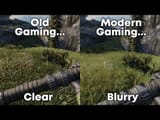>>714435598 (OP)>Why did TAA become the main default option for Anti Aliasing in all recently released video games? It makes absolutely no sense. It's genuinely the shittiest out of all of themTAA became the main default option because the main image issues in modern games aren't some jaggies you'd see in still screenshots, it's the visual warping of the image during movement. Temporal aliasing, flickering, shimmering, the problems that happen when you try to stick too much graphics into too little resolution so it looks unstabble and garbled in motion. Other antialiasing solutions either don't mitigate these issues or their performance cost is unreasonable.
FXAA and SMAA address static geometric aliasing and won't stop a game from flickering or shimmering.
MSAA isn't really compatible with modern rendering techniques which means it doesn't actually fix aliasing or flickering or shimmering - even worse is the fact that even if it magically is compatible it still has a huge performance cost and bandwidth cost. However in FORWARD RENDERED games (which are very rare nowadays) MSAA is great.
SSAA is very good for image quality but its performance cost is massive, and it's an extremely bad deal in case of how little visual upgrade you get for the massive performance loss. And believe it or not, SSAA by itself still cannot address all image instability problems in motion because it's not a temporal solution.
TAA is the only antialiasing method that effectively mitigating temporal aliasing such as flickering or shimmering. Nothing else comes close. Problem is that TAA's solutions just introduce different new problems to replace old problems. Which is not a good solution but at least it attempts to address the issues, trying to force old legacy antialiasing methods to fix modern image issues is like shouting at the rain to stop. There's a reason games rarely offer FXAA/SMAA/MSAA anymore, they're not viable solutions.






